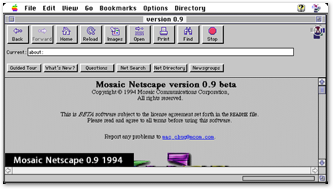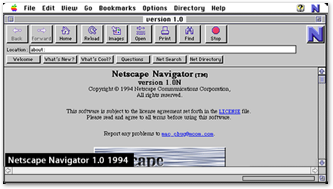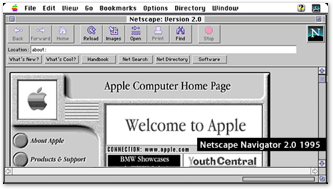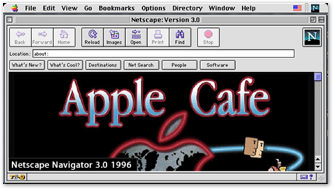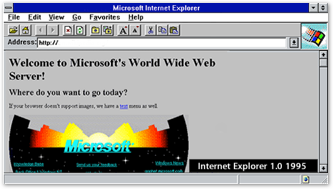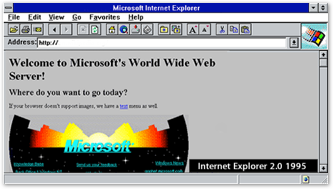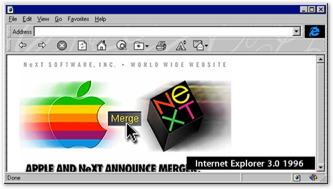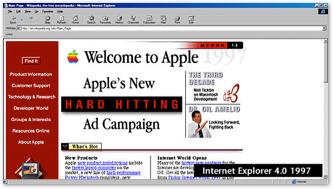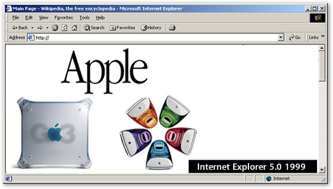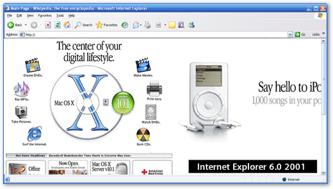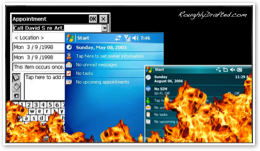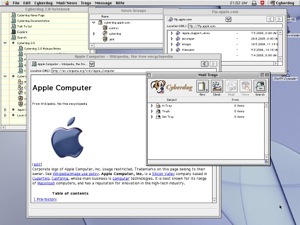

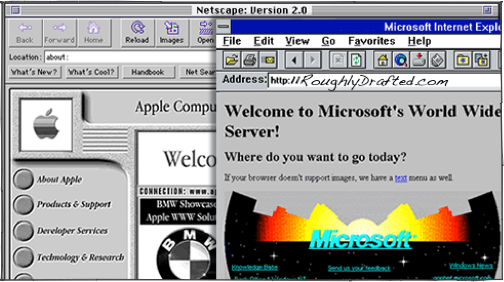
Apple’s surprise delivery of the Safari web browser for Windows at WWDC was described by several writers as a revival of the browser wars between Netscape and Microsoft between 1995 and 2003. Why would Apple want to start another conflict after the brutal annihilation of Netscape?
Further, why was the tech world launched into a web war in the first place, what lessons were learned, and how was it that Netscape--which once held 80% of the browser market--was defeated by Microsoft?
Surely many of those same details will apply to Apple’s launching of Safari against the entrenched position of Internet Explorer. It therefore makes a lot of sense to consider the events from just a few years ago in order to determine why Apple is releasing Safari for Windows, and what outcome its new browser will have.
The World Wide Web Before the Browser Wars.
The previous article presented an overview of the contributions made by governments, companies, researchers and even volunteer students working to build an open, new way to share information over the Internet.
In the late 80s, Apple’s free HyperCard authoring system sparked an initial interest in ordinary people--even those lacking any particular technical expertise--to create and share information as HyperCard stacks, which served as a precursor to today’s interactive websites, wikis, and widgets.
Inspired by the model of HyperCard, researchers and students from around the world worked together to design a standard system for sharing linked documents on a worldwide scale, independent of any territorial boundaries.
The US government invested in building infrastructure and defining standardized, open protocols for development of the web as a key Internet service. Those standards were shared with the world community, enabling everyone to build compatible, interoperable networks. Part of that early investment also resulted in the NCSA Mosaic web browser, which was distributed for free to non-commercial users.
By 1993, the popularity of the Internet began to explode as the web made it both easy and intuitive for common users to look up information and even freely publish their own.
Why did a war suddenly erupt to tear this era of prosperity and open technological advancement apart? That question is always an easy one to answer: money was involved, and lots of it.
The Rise of Netscape: 1993 - 1996.
Marc Andreessen, who led the NCSA’s Mosaic browser development as a student at the University of Illinois at Urbana-Champaign, graduated in 1993. He went on to found Mosaic Communications, later renamed Netscape, with the goal of delivering the commercial Netscape Navigator web browser.
Andreessen partnered with Jim Clark, who a decade earlier had graduated from Stanford University in California to start up Silicon Graphics. Armed with his experience at SGI, Clark helped Andreessen develop a business plan for continuing the development of the Navigator browser.
With the availability of other free browsers, including Mosaic, Netscape decided to give away its web browser client and planned to make money selling web server software.
Netscape’s initial rapid innovation and its adoption of Mosaic’s policy of being free for non-commercial use quickly made its browser the new standard for web users.
A Threat To Microsoft’s Desktop Monopoly.
Facing the immediate obsolescence of MSN before it was even released, Microsoft eventually scrambled to rejigger its online strategy to shift from an AOL model to one copying Netscape. In the face of rapidly expanding Internet access, the market for closed online services like AOL offered little potential for future profits.
The relatively small web server market was likely not significant enough to interest Microsoft. However, it knew that Netscape’s control of the web browser posed a significant threat to its monopoly position on the desktop.
The new web browser was increasingly expanding from a simple way to access hyperlinked documents into a thin client application platform that promised to eventually deliver sophisticated, interactive applications. The most dangerous aspect of this plan was that Netscape wanted to make these web applications work on any platform.
Netscape pointedly marketed the web browser as the next new platform, and described its browser as the best way to develop cross platform applications that all worked identically, whether running its browser on Windows, Linux, OS/2, the Macintosh, or one of the several flavors of commercial Unix: DEC Unix, Sun Solaris, BSDI, SGI IRIX, IBM AIX, and HP-UX.
By 1996, Netscape was delivering support for Sun’s Java. Paired with the browser, Java promised to deliver a simple, cross-platform development environment that could serve as a broad replacement to Windows.
Microsoft's Windows platform depended upon third party developers, who in turn depended upon Windows. If developers began using the web to deliver applications that were not tied to Windows, Microsoft recognized that the PC desktop would be opened up to competition. That would deflate the Windows-centric development that helped keep Microsoft's monopoly afloat.
Microsoft had to ensure that all web development was also tied to Windows. That required the company to get into the web browser business itself.
Microsoft Enters the Browser Market: 1995 - 2001.
In 1995, Microsoft licensed web browser technology from Spyglass--a parallel commercial spinoff of the NCSA Mosaic project--to develop Internet Explorer as its own browser in order to destroy Netscape as a threat.
Microsoft invested significant resources into IE, outpacing Netscape both in development and marketing. It not only bundled IE with Windows--in violation of its earlier consent decree--but also used its marketing clout to push ISPs to distribute IE instead of Netscape.
Using the threat of delaying Office for the Mac, Microsoft also signed a deal with Apple to force Netscape off the Mac desktop and therefore handicap Netscape’s efforts to provide a cross-platform browser.
After rapidly gaining web browser market share in 1997 as the default Windows browser, Microsoft introduced a variety of initiatives to tie web-based development to IE and Windows. Microsoft similarly worked to link Java development to Windows and the IE browser, killing interoperability for both Java and the web.
Once the threat posed by Netscape was neutralized, development of IE rapidly leveled off, particularly on the Mac platform, which Microsoft had entered solely to end Netscape’s cross-platform reach.
With web development tied to the IE browser and to dependancies in Windows--particularly within Enterprise environments--Microsoft could now stop innovating and begin raising prices for its IIS web servers and other elements of its plans to make the web just another proprietary extension of the Windows desktop platform.
Netscape Hoist With Its Own Petard: 1997-1998.
While Netscape certainly fell spectacularly as Microsoft entered the web browser business, the populist idea that Netscape had no chance against Microsoft fails to take into consideration two things:
First, while Microsoft appeared to expertly destroy Netscape's market leading browser business in short order, the company has since demonstrated its inability to compete against a variety of rivals:
-
•Google in the search and web marketing arenas.
-
•Apple in the consumer electronics and desktop operating system arenas.
-
•Linux integrators in the server and embedded arenas.
Perhaps the old idea that Microsoft was an unstoppable juggernaut with a brilliant capacity to kill all who dared rival it was actually a misinterpretation of the reality that Microsoft's large competitors--who fell dramatically in battle and were forced to offer the company their majority market share in tribute--were in reality just slightly more incompetent than Microsoft itself.
Second, Netscape clearly failed in the market largely due to its own problems. The first error was strategic; the second was a mix of product management and development problems.
Just like Microsoft, Netscape’s strategy was to lock up the browser market and tie web development to its own non-standard extensions to HTML, in order to push the adoption of its own web server software. That resulted in a product that was no better for consumers and businesses than Microsoft's IE.
On top of that flawed strategy, Netscape also simply executed poorly. After rapidly delivering four generations of its Navigator browser between 1993 - 1997, Netscape's ongoing development plans began falling apart.
Its own engineers were conflicted about whether to continue development of the top-heavy and increasingly problematic Navigator 4 code base, or to start over with an entirely re-architected new web rendering engine.
What We Have Here Is a Failure to Communicator.
Netscape ended up doing both. First, Navigator 4 was replaced with a suite of products called Communicator 4, which tacked on an email client, a newsgroup reader, an address book, calendar, collaboration tools, a push client, and an HTML editor.
Netscape’s aging, top heavy browser was now plagued with a series of marginal companion products that nobody really wanted. Communicator was trying to compete with Microsoft by becoming the user’s entire desktop.
In order to deliver this cross-platform, Communicator had to bypass the native operating system, turning the web browser into an environment closer to X11, Gnome, or KDE. This strategy was unattractive to both Mac and Windows users not just because it looked and worked differently, but that it offered more bugs than advantages.
The Great Leap Forward.
At the same time, Netscape also embarked upon parallel plans to completely rebuild an entirely new browser engine, which ended up taking many years to complete.
That put Netscape in the position of Apple during its Pink/Copland period between 1991 and 1995: scrambling to dust off an aging, overextended relic while at the same time laying out grandiose plans that would be a stretch to actually deliver.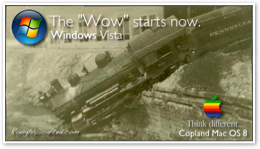

Of course, it didn't help that Microsoft was steadily advancing its competitive efforts, or cutting off Netscape's air supply on the Macintosh platform with its Apple deal, but Netscape’s most significant problems appear to have largely been of its own making.
Netscape Crashes, Dies: 1998 - 2000.
As part of its plans to completely rewrite Communicator 4, Netscape released its web browser code as the Mozilla open source project. Netscape hoped to create a community of developers interested in working on a standards-based browser that could compete against the dominant progression of IE.
In 1998, Netscape dropped its original plans to deliver Netscape 5 as significant revision to Communicator 4. Instead, it chose to freeze development of the classic Mariner engine and wait for the completion of a completely rewritten new one called Gecko. That ended up taking much longer than originally anticipated.
In 1999, AOL paid $4.2 billion for Netscape, hoping to use its new browser as a platform for modernizing the AOL service from a proprietary system of custom content to a web-based one. That business plan was complicated by the problematic ongoing development of the new Gecko-based browser.
Between a Rock and a Hard Place.
As a new open source community project, the Mozilla Organization had been working since 1998 to deliver the Gecko engine, but progress was slow. Desperate for results, AOL pressed the Netscape team to ship Mozilla’s beta code as Netscape 6 in 2000, resulting in public embarrassment and further associating the Netscape brand with incompetence.



Two years deep into its Mozilla experiment, Netscape was stuck with the now ancient Communicator 4 mess while also trying to spin out a very rough early beta of the Mozilla code. Skipping a fifth generation to catch up in version numbers to Microsoft's IE hadn’t fooled anyone: Netscape was now considered a dead end, junk browser.
In comparison, Microsoft delivered progressive new releases of IE in 1997, 1999, and 2001, leapfrogging Netscape in innovative new browser features. Netscape only gave consumers and business users a choice between an old, buggy, and slow Communicator 4 and the unfinished, buggy, and slow Netscape 6.
It's not hard to understand why Netscape rapidly failed to matter; even AOL continued to use IE for its browser! Not even the mothership could love it.
Having fully eclipsed Netscape, Microsoft now owned the entire browser market, both on Windows and on the Mac. With no further need to compete or innovate, Microsoft subsequently dropped IE for the Mac platform and did not even release another major revision on Windows until late 2006, five years later.
Reinventing Failure with the Mozilla Application Suite: 2000 - 2003.
Having watched in horror as AOL prematurely rushed out a release of its beta code, Mozilla developers attempted to distance themselves from AOL and the Netscape name by outlining an independent set of objectives under the name Mozilla Application Suite.
However, rather than trying to deliver a simple, streamlined version of a modern, standards-based Gecko web browser to compete against Microsoft’s IE, Mozilla inexplicably decided to deliver an entirely rewritten version of the unwieldy mess of Communicator, albeit with more fashionable bells and whistles.
The Mozilla Application Suite envisioned itself as a platform for Internet applications with a programmable user interface and a modular architecture.
Mozilla hoped to replace or at least challenge Windows-centric application development with an entirely new system based on client apps with a user interface defined in a markup language Mozilla called XUL, and incorporating development based upon web standards.
The Endless Platform of Platforms.
While interesting and innovative, XUL development results in limited set of applications that can only run using Mozilla’s XULRunner runtime, giving the entire concept a similar fate to those promising failures of the past:
-
•OpenDoc component software.
-
•The OpenStep frameworks the world ignored back in 1996.
-
•Sun’s plans for desktop Java VM and Java browser applet development.
...and those promising failures of the future:
-
•Adobe’s Flex and AIR platforms based on Flash application development.
-
•Microsoft’s Silverlight, and perhaps even .Net, although Microsoft’s failures are often considered successes.
-
•Sun’s JavaFX, which offers some new, closed extensions to Java. [Luke deGruchy: JavaFX is open source.]
You Can Lead a Horse to Water...
The grandiose plans of the Mozilla Application Suite went absolutely nowhere. By way of comparison, Apple’s mature and demonstratively effective Cocoa development tools have seen only moderate adoption, despite being offered for seven years now, and having an impressive legacy dating back into the early 90s.
Apple is its own biggest customer of Cocoa, using it to build its own applications. Despite Cocoa’s enabling Apple to outmaneuver Microsoft and enjoying a reputation as a highly regarded platform framework, the plain fact is that introducing a new development platform is almost impossibly difficult.
If Cocoa bucks convention, imagine the plight of something unproven. Even Microsoft--which happened to be in the right place at the right time to use IBM’s PC as a vehicle for DOS and then Windows--has had extreme difficulties in building successful development platforms around WinCE, Windows Mobile, its various DRM and media platform ideas, and its DVR and Media Center plans.
Because establishing a new platform is so difficult, the barriers have to be very low, and the payback has to be very rewarding. That is in part why Apple has avoided opening the iPhone to third party development, outside of the recent announcements to support applications designed to common, modern web standards.
More about that later! But first, what was Apple doing during the web wars, how did the battles between Netscape and Microsoft impact the Mac, and what lessons were learned?
The Mac Internet Before Safari: 1993-2003.
In the decade prior to the release of Safari, Apple introduced two major initiatives related to Internet services on the Mac platform. The first was the Apple Open Collaboration Environment associated with PowerTalk, which in 1993 predated the commercial web and instead focused on email services and LAN document sharing.
As AOCE fell apart as a grandly over-architected project, Apple worked to replace it with Cyberdog, a suite of Internet tools built as OpenDoc application components: a web browser, ftp client, news and email services.
Cyberdog was largely a demonstration of the potential of OpenDoc. As such, it demonstrated that OpenDoc was a solution to a problem that did not really exist. Nobody wanted to assemble components; they wanted regular apps.
Cyberdog also demonstrated the principle of unintended consequences; it promised to replace the monolithic, bloated code in suites like Netscape’s Communicator, but it required loading support libraries that erased any intended benefits, ending up slower and fatter that what it hoped to replace.
It also demonstrated how much resistance there is to any effort to rethink the foundations of the software industry, or perhaps to challenge any fundamental idea of any kind. Cyberdog was thrown out along with OpenDoc in early 1997. By that time, the browser wars were well underway, and the Mac was at the middle of things.
Apple in the Browser Wars.
As a strategic battlefield in the war between Netscape and Microsoft, Apple had the luxury of not really needing to develop its own browser for the Mac as its own attempts to deliver Cyberdog failed. That was handy because Apple had plenty of other things it desperately needed to do.
Netscape viewed Apple as a critical component to its web platform strategy, as the Mac offered a clear example of how the browser could provide cross-platform solutions. Microsoft responded by rushing out a version of Internet Explorer for the Mac in 1996, and then scrambled to marginalize Netscape’s browser in a closed deal with Apple.
However, once the browser wars ended around 2001, Microsoft had no reason to continue development of its Mac browser, and Netscape was in no position to offer anything for the Mac apart from a placeholder build of the clumsy Mozilla Application Suite that nobody was using anyway.
The stagnation of web browsers on the Mac after 2001 was a problem Apple decided to address itself, since using the web was a key feature to its prime consumer and education markets.
Two Wrongs Make a Right.
Apple’s past failure with Cyberdog components and Mozilla’s failure with its Application Suite left both entities looking unlikely to rush back into battle with Microsoft any time soon.
After a brief resurgence during the dotcom years, Apple was again struggling to maintain Mac sales during an economic downturn, and Mozilla had been reduced to a volunteer effort. In 2003, AOL pulled the plug on Netscape, leaving Mozilla--which was mostly Netscape employees--to incorporate as a non-profit foundation.
Things were looking bleak for anyone interested in an open future for the web. However, in 2003 both Apple and Mozilla ignited a renaissance in browser development inspired by the ancient classic ideals of an open web.
A new emphasis on open, interoperable, and standards-based browsers would rapidly change the landscape of the web. Coming up next: The Web Browser Renaissance: Firefox and Safari.
Like reading RoughlyDrafted? Share articles with your friends, link from your blog, and subscribe to my podcast!
Did I miss any details?

Haloscan Q107
 Bookmark on Del.icio.us |
Bookmark on Del.icio.us |  Discuss on Reddit |
Discuss on Reddit |
 Critically review on NewsTrust
Critically review on NewsTrust
 Forward to Friends |
Forward to Friends | 
 Get RSS Feed |
Get RSS Feed |
 Download RSS Widget
Download RSS Widget
Check out the Daily Show Multi-Pass on iTunes.com

Next Articles:
Does Leopard Look Like Vista?
BHOze and the BHOzing BHOzers that BHOze Them.
EA’s Intel Mac Games: WINE and Cheese??
This Series
Apple in the Web Browser Wars: Netscape vs Internet Explorer
Tuesday, June 19, 2007

Ad




